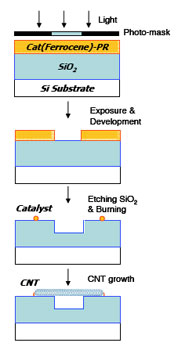| Posted: Feb 06, 2006 | |
Researchers succeed in overcoming positioning issue in CNT-based ICs |
|
| Researchers from the Samsung Advanced Institute of Technology (SAIT) in Korea report a direct photolithographic route to selective growth of single-walled carbon nanotubes (SWNTs). The findings with the title "Direct photolithographic route to selective growth of single-walled carbon nanotubes using a modified photoresist with ferrocene" were published on Jan. 14, 2006 in Nanotechnology. As Wanjun Park from SAIT told Nanowerk, "this success will present the novel concept to overcome the positioning issue of nanotubes that is a major technical barrier for the CNT-based integrated circuits." | |
 |
Inspired by the way how CNTs selectively grow to integrate molecular electronic
components over a large area, the method utilizes a simple mixture of ferrocene and
conventional photoresist as a catalytic photoresist (Cat-PR). Using the Cat-PR, catalytic nanoparticles with diameters of 3–10 nm were formed on the defined regions and SWNTs with diameters of 1.0–1.5 nm were selectively grown on the pre-patterned catalyst. For the successful growth of SWNTs on the pre-defined regions, all organics of the Cat-PR should be completely removed by a burning process in order to obtain catalytically active nanoparticles. The standard photolithography and etching process, which is performed with conventional PRs, was applied to the single and isolated CNT growth. This facilitation was also successfully tested with the direct growth of the suspended nanotubes between the etched oxide poles with the novel direct photolithographic method. |
| The quality and density of the grown SWNTs were dramatically improved by supplying water vapour during the nanotube growth, possibly due to the enhanced activity of nanoparticles. Most radial breathing mode peaks of the grown SWNTs in Raman spectra from 785 nm laser excitation are assigned to the semiconducting nanotubes. It is also demonstrated that nanotubes suspended between three-dimensional stands can be easily prepared by using the Cat-PR patterns as an etch mask. | |
 By
Michael
Berger
– Michael is author of three books by the Royal Society of Chemistry:
Nano-Society: Pushing the Boundaries of Technology,
Nanotechnology: The Future is Tiny, and
Nanoengineering: The Skills and Tools Making Technology Invisible
Copyright ©
Nanowerk LLC
By
Michael
Berger
– Michael is author of three books by the Royal Society of Chemistry:
Nano-Society: Pushing the Boundaries of Technology,
Nanotechnology: The Future is Tiny, and
Nanoengineering: The Skills and Tools Making Technology Invisible
Copyright ©
Nanowerk LLC
|
|
Become a Spotlight guest author! Join our large and growing group of guest contributors. Have you just published a scientific paper or have other exciting developments to share with the nanotechnology community? Here is how to publish on nanowerk.com.
